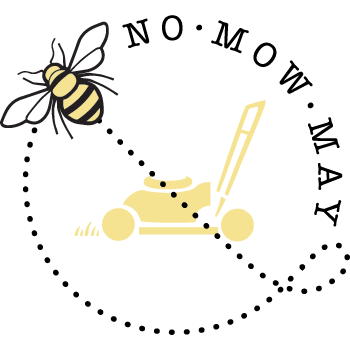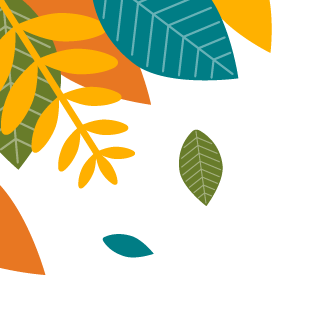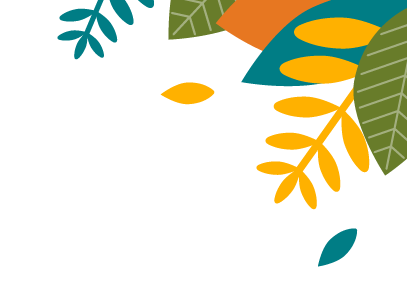NO MOW MAY
No Mow May!
Welcome to No Mow May: an initiative to rethink how your backyard and green spaces can provide resources to the pollinators that we all rely on during a critical time for their survival. There are many ways you can participate – every yard is different and needs to suit the use of your household. By limiting mowing and yard clearing during May we can allow flowering resources to flourish and provide more time for overwintering pollinators to emerge from hibernation. Pesticides cause harm to pollinators – eliminating or reducing your use of pesticides is a big step in the right direction. You may even be supporting a federally endangered species in your backyard – queen rusty patched bumble bees begin emerging throughout the month of May and need flowering resources to feed on. Planting native pollinator-friendly plants and transitioning your turfgrass to flowering bee-friendly lawns can greatly impact pollinator abundance and overall biodiversity. We encourage you to read through the resources on this page and rethink how your yard can be a better habitat for the pollinators that we depend on.
Make sure you check your local ordinances on lawn-height requirements and obey your city, village or town laws. If your neighborhood has such an ordinance, contact your representatives and let them know why it’s important to allow time for overwintering pollinators to emerge during May and throughout the summer. Tell them why pollinators are so critically important to our yards and our wellbeing.
There’s no one-size-fits-all for No Mow May – some may even still need to mow. We don’t need one perfect yard for pollinators, we need thousands of imperfect yards for pollinators! Find out how you can take action this spring (and throughout the rest of the season) to help conserve pollinators and wildlife in your backyard.

How can I participate?
1. Reduce mowing and yard cleanup during May.
This allows flowering resources to grow and providing more time for overwintering pollinators to emerge. Enter your address in our searchable map below to see if you live in an area with an approved No Mow May policy.
2. Eliminate or reduce use of pesticides.
Pesticides, especially neonicotinoids, are the greatest threat to pollinating wildlife including bees, butterflies, birds, and bats.
3. Create No Mow Zones and plant native pollinator-friendly flowering plants to provide resources to pollinators.
4. Transition turfgrass lawn to flowering lawn or low-mow grass species.
Our favorites to plant that hold up well to foot traffic are self-heal, white clover, and wild strawberries!
Continue reading below to learn more about the growing research on the importance of our yards to pollinators, when to mow your lawn, and how to support pollinators in your backyard during May and throughout the season.
Are you a renter? See this post for tips on how to approach your landlord about participating in No Mow May.
When Should I Mow My Lawn?
Reducing mowing is one way to support pollinators in your backyard during No Mow May and throughout the summer for a Low Mow Summer. Every lawn is different and needs to be managed best for you and your household. Below are some tips to keep in mind as you think about when to mow your lawn this spring and summer:
- Follow the 1/3 rule and prevent grass shock! When mowing longer grass, remove only 1/3 of the total height off of the plant. This helps prevent the grass from becoming stressed and allows for healthier overall growth.
- If interested in keeping a longer lawn during the entire summer to support pollinators, raise your mower blades to 3 inches or higher.
- Be sure to consult your local ordinances when deciding on your lawn height. You can reference our No Mow May guidelines map for information on the ordinances in your community.
- If you are concerned about the spread of dandelions in your yard, leave them be to provide some resources to early season pollinators and then make sure to mow before they go to seed.
- If you’ve let your lawn grow through May, there may be critters living in your lawn! Walk through and inspect your lawn before mowing, and instead of mowing from the outside in, start from the inside and work outwards to allow critters time to move to edges and unmowed areas. For additional precaution, slow down your mowing speed!
- The best time to avoid eliminating insect pollinators when mowing is during the hottest and sunniest part of the day. Insects will be most active and able to avoid getting caught in the mower.
For more information about lawn maintenance, see UW Extension’s Lawn Maintenance Guide and UMN Extension’s Mowing Practices for Healthy Lawns.
Growing Research
Research suggests that our urban gardens and lawns are a valuable, dependable resource for bumble bee populations – just as much as rural green spaces! By planting and growing native pollinator-friendly plants you are directly contributing to habitat restoration for the pollinators we depend on. The more homes that participate, the more habitat we are able to provide.
No Mow May encourages you to rethink yards and green spaces as habitat for pollinators, which is especially important because studies indicate that pollinator species have experienced significant population decreases (Zattara et al, 2021). A 2023 study of flowering lawns found that florally-enhanced lawns supported more diverse bee communities and more visitation by native bees (Wolfin, et al 2023). Converting monoculture green lawns into flowering spaces is one of the best ways to support pollinators in your backyard. For more information on what to plant, scroll down to find links to native plants lists.
Citations
Fluri, P., & Frick, R. (2002). Honey bee losses during mowing of flowering fields. Bee world, 83(3), 109-118.
Proske, A., Lokatis, S., & Rolff, J. (2022). Impact of mowing frequency on arthropod abundance and diversity in urban habitats: A meta-analysis. Urban Forestry & Urban Greening, 76, 127714.
Tew, N. E., Baldock, K. C., Vaughan, I. P., Bird, S., & Memmott, J. (2021). Turnover in floral composition explains species diversity and temporal stability in the nectar supply of urban residential gardens. Journal of Applied Ecology.
Wolfin, J., Watkins, E., Lane, I., Portman, Z. M., & Spivak, M. (2023). Floral enhancement of turfgrass lawns benefits wild bees and honey bees (Apis mellifera). Urban Ecosystems, 1-15.
Zattara, E. E., & Aizen, M. A. (2021). Worldwide occurrence records suggest a global decline in bee species richness. One Earth, 4(1), 114-123.
No Mow Zones
If you’ve recently visited the Milwaukee County Zoo, you may have noticed some areas around the Zoo indicating with signs that they are ‘No Mow Zones’. These Zones actually began seven years ago, when Milwaukee County Zoo Horticulturalists tried a new strategy for dealing with an unruly plot of land by letting it be. They replaced invasive plant species with low-mow grass species and created a self-sustainable plot. Over the years, hours of labor were eliminated, landscaping costs were cut and pollinators grew abundant in these zones. Some of the zones are filled with grass, some with flowers, all of them are bustling with bees, butterflies, moths, and birds. You can replicate this in your yard at home! By providing a smaller No Mow Zone plot in your yard, you can help conserve and support our local pollinators too.
Support an Endangered Species!
Did you know that there might be an endangered species in your backyard No Mow Zone? The rusty patched bumble bee was placed on the Federal Endangered Species List after surveys found a 90% drop in population abundance. Previously, this bumble bee species used to be found in 31 US states, and has been reduced to 10 states in the Midwest region. Southeastern Wisconsin and Northern Illinois have been highlighted as priority habitat for rusty patched bumble bee conservation. There is still much we have to learn about this species, how they nest, and how we can conserve remaining populations. Go to the USFWS Rusty Patched Bumble Bee page to learn more about conservation efforts. Go to the Wisconsin DNR’s Bumble Bee Brigade page to find out how you can support community science observations and bumble bee ID.
Bumble bee conservation efforts Help the DNR collect bumble bee data
Find out if your municipality has approved No Mow May!
Use the map and search for your address to find out if No Mow May has been approved in your town or municipality in Wisconsin. Zones colored in yellow do not require registration. Zones in the map colored in red do require you to register your home in order to participate. Follow the link to register your home and learn more about how your community is supporting No Mow May.
To use the map:
- Click on the search icon and enter your address. Make sure you include all letters, ex. include ‘st’ in ‘91st’ or ‘th’ in ‘5th.’
- To follow the municipal link to learn more, left-click anywhere on the screen in the municipal zone and then left-click “More info.”
![]() = Registration not required.
= Registration not required.
![]() = Registration is required to participate.
= Registration is required to participate.
List of communities participating in No Mow May in Wisconsin
No registration required:
Appleton
Cross Plains
Elm Grove
Fort Atkinson
Fox Crossing
Fox Point
Glendale
Greendale
Greenfield
Hortonville
Medford
Shorewood
Stevens Point
Superior
Verona
Wauwatosa
Whitefish Bay
Wisconsin Rapids
Registration required:
Cudahy
De Pere
Egg Harbor
Green Bay
Kaukauna
La Crosse
Ledgeview
Marshfield
Milwaukee
Oshkosh
Sun Prairie
This list is up to date as of March 18, 2024. If your community is participating and is not included, please contact us at conservation@zoosociety.org to let us know.
Resources for Pollinator-Friendly Yards

- Managing Invasive Plants in your Yard
Removing invasive plants that crowd out native plants favored by wildlife is an important tool for creating pollinator-friendly habitat.- View the Midwest Invasive Plant Network’s brochure guide to Landscape Alternatives for Invasive Plants of the Midwest (PDF) for basic information on plant species to remove, watch or maintain. For more detailed information view their Homeowner’s Guide to Landscaping with Native Plants to Ward Off Invasives & Benefit Wildlife (PDF).
- For a deeper dive into invasive plants, including photos and detailed fact sheets, click on the Master Resource Table on the Renz Weed Science Lab at the University of Wisconsin website.
- Native WI Plant Species Lists
Looking for additional resources on plant species to put in your pollinator-friendly yard? Click below to learn about different native-pollinator friendly plants:- Wisconsin DNR’s Native Plants for Beginners List (spring, summer, and fall bloomers!)
- Wisconsin DNR’s list of Native Plant Nurseries (List of where to buy native pollinating plants!)
- Xerces Great Lakes Region Pollinator Plant Guide (PDF)
- Midwest Grows Green guide to growing environmentally friendly lawns and gardens (PDF)
- Lake Michigan Bird Observatory – Neighborhood Habitat Improvement Project
Join the Lake Michigan Bird Observatory’s Neighborhood Habitat Improvement Project for guidance on creating habitat in your backyard with native plants and to contribute to their community science monitoring research on the impact of urbanization on birds. - University of Minnesota Extension – Bee-Friendly Lawns
Transitioning your turfgrass lawn into flowering lawn can provide critically needed food resources to pollinators and allow you to lower your mowing throughout the season. Visit the University of Minnesota Extension’s website on Bee-Friendly Lawns for detailed guidance on how to make the transition to and manage a beautiful bee-friendly lawn for years to come. - Save Our Songbirds WI Native Plant Sale List
To find native plant sales across the state of Wisconsin visit the Save Our Songbirds WI Native Plant Sale List to find a sales event or native plant retailer near you.

How else can I help?
1. Get in touch with your local representatives to learn how to change lawn-height requirements in your community!
Many city departments and neighborhood associations have lawn requirements that limit the height of the grass in your yard. Because these rules vary depending on where you live, we recommend you look up the guidance in your area and contact your local officials to let them know how important pollinators are to our gardens. Join other community scientists in advocating for pollinator-friendly habitat and work to change lawn-height requirements in your community.
2. Create shelter and habitat for pollinators by building an “insect hotel”!
Insect hotels are areas where bugs live and eat. Insect hotels can be organized piles of brush, yard clippings, or nicely stacked wooden structures that create the perfect home for native insects. Providing an insect hotel in your yard can provide an area for native insects to live and roost safely in your yard.
3. Pledge to protect pollinators past May.
Take the Midwest Grows Green (MGG) pledge to create pollinator habitat and eliminate your use of harmful chemicals to pollinators. Pledge takers gain access to a monthly sustainable landscaping newsletter from our friends at MGG.

